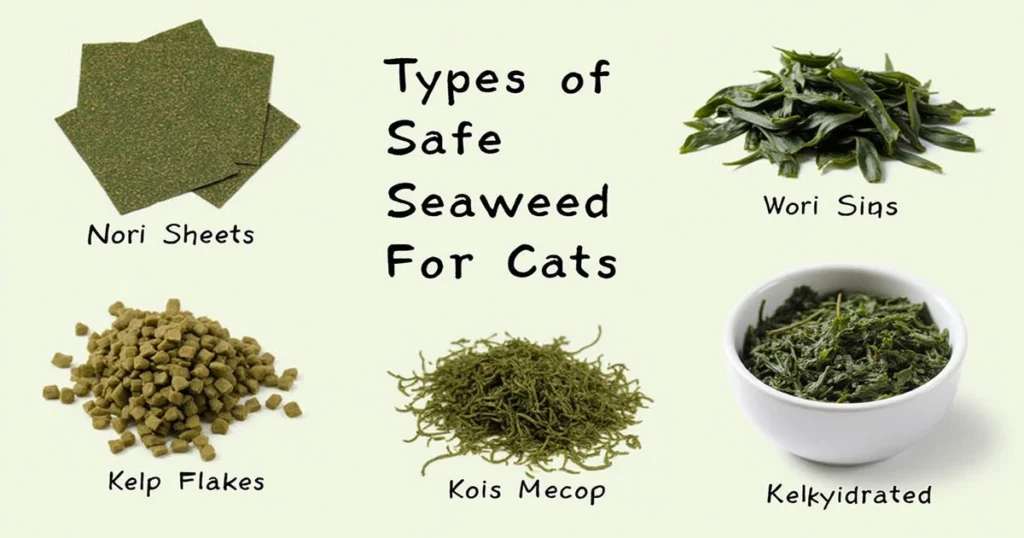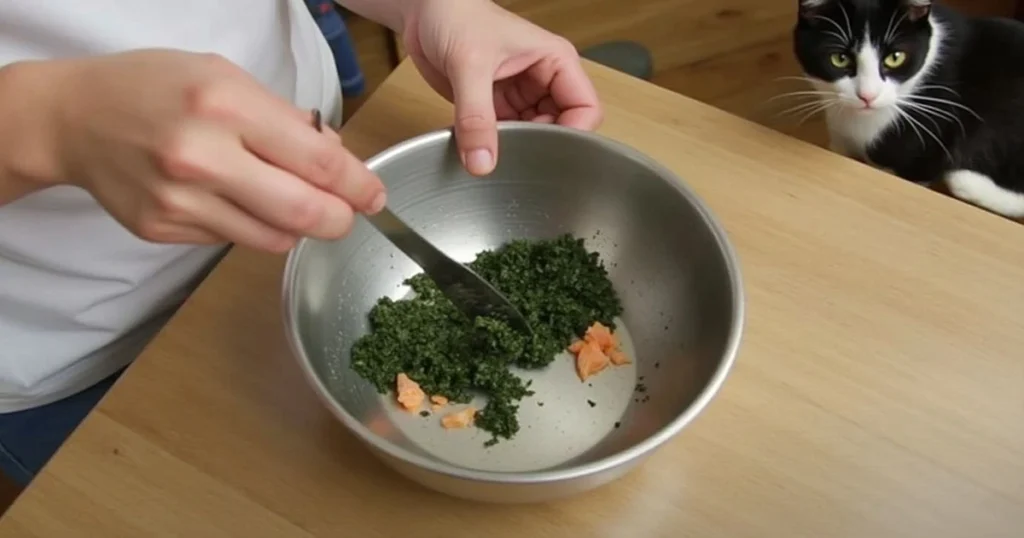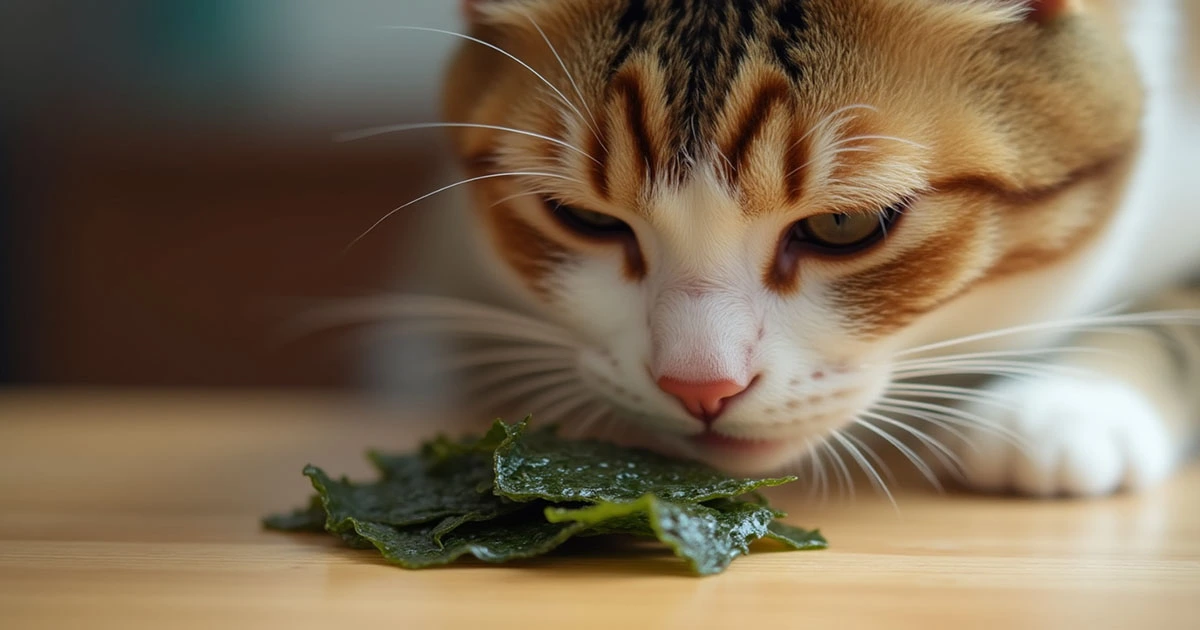As pet owners, you might wonder if seaweed is good for your cat. Seaweed is seen as a nutritious food, but is it safe for cats? We’ll look into whether seaweed is right for your cat, covering the good and the bad.
Seaweed is a group of marine algae that people eat a lot. But, its role in pet food is not as clear. Knowing about different seaweeds, their nutrients, and effects on cats is key.
Table of Contents
Understanding Seaweed and Its Types for Feline Consumption
Seaweed might not be the first thing you think of for your cat’s food. But, it’s packed with nutrients and can be good for them. Knowing about the different kinds of seaweed, their health benefits, and how they’re sold can help you add seaweed to your cat’s meals wisely.
Different Varieties of Edible Seaweed
There are many kinds of seaweed, each with its own benefits for cats. Some popular ones include:
- Nori – A red algae used in sushi, safe and tasty for cats.
- Kombu – A brown kelp with a rich flavor and lots of minerals.
- Wakame – A green seaweed good for soups or salads for cats.
- Spirulina – A vibrant blue-green algae rich in proteins, essential vitamins, and powerful antioxidants.
Nutritional Components of Seaweed
Seaweed is full of important nutrients for cats. It has vitamins, minerals, and other good stuff. Some key nutrients in seaweed are:
| Nutrient | Benefits for Cats |
|---|---|
| Iodine | Helps the thyroid and metabolism |
| Calcium | Good for strong bones and teeth |
| Omega-3 fatty acids | Good for skin, coat, and brain health |
| Antioxidants | Protects cells and boosts the immune system |
Common Forms of Seaweed Products
Seaweed comes in many forms for cats, like:
- Dried or dehydrated flakes or powder
- Freeze-dried treats or snacks
- Seaweed-based supplements or pet foods
- Fresh, raw seaweed (for cats who like to graze)
Knowing about the different seaweed types, their nutrients, and product forms helps you safely add seaweed to your cat’s diet.
Can Cats Eat Seaweed?

If you own a cat, you might wonder: can cats eat seaweed or is seaweed safe for cats to eat? The answer is mostly yes, can cats eat seaweed snacks without major health risks. But, there are a few things to think about before giving seaweed to your cat.
It’s crucial to know the type of seaweed. Not all seaweed is safe for cats. Some types are better for them, while others might upset their stomachs. Make sure to only give your cat seaweed that’s made for cats.
- Certain types of seaweed, like nori, are okay for cats in small amounts.
- But, kelp or spirulina might not be as good and could cause problems if eaten too much.
- Always talk to your vet before adding new foods, including seaweed, to your cat’s diet.
Also, think about how you prepare and how much seaweed you give your cat. Avoid processed or seasoned seaweed snacks because they might have bad stuff for cats. Use plain, unsalted, and unprocessed seaweed and only give a little bit as a treat.
| Seaweed Type | Suitability for Cats | Potential Concerns |
|---|---|---|
| Nori | Suitable in moderation | May cause digestive issues if consumed in excess |
| Kelp | Less suitable | High in iodine, which can be problematic for some cats |
| Spirulina | Less suitable | May cause digestive upset or other health problems |
By knowing how to feed seaweed to cats and listening to your vet, you can add this healthy food to your cat’s diet safely. It can be a fun and nutritious treat or supplement.
Health Benefits of Seaweed for Your Feline Friend
Seaweed can be a great addition to your cat’s diet. It’s full of important minerals and vitamins. These vital nutrients play a key role in supporting your cat’s overall health and well-being.
Essential Minerals and Vitamins
Seaweed is packed with nutrients that are good for your cat. It has lots of iodine, which is key for a healthy thyroid. It also has vitamins A, C, E, and B-complex. These vitamins help your cat’s immune system and skin.
Digestive Health Advantages
Adding seaweed to your cat’s diet can help their digestion. Packed with fiber, spirulina can aid in regulating bowel movements and preventing constipation. It also feeds the good bacteria in your cat’s gut, boosting their immune system.
Immune System Support
Seaweed is full of antioxidants and anti-inflammatory compounds. These help support your cat’s immune system. They can reduce inflammation, fight infections, and boost your cat’s disease-fighting abilities.
Knowing the health benefits of seaweed for cats helps you make smart choices. Whether it’s can cats eat nori or other seaweed for cats products, your cat will benefit from it.
Potential Risks and Safety Concerns of Feeding Seaweed to Cats
Seaweed can be good for cats, but it’s important to watch out for risks. Too much or the wrong kind of seaweed for pets can cause problems.
Some cats might have allergies to certain seaweed sheets. This could make their skin, stomach, or breathing issues worse. Begin with small portions and monitor closely for any adverse reactions.
Changing your cat’s diet too fast can upset their stomach. This might cause vomiting, diarrhea, or constipation. Make sure to add is seaweed bad for cats slowly and carefully.
Too much seaweed can also mess with your cat’s iodine levels. While iodine is good, too much can harm their thyroid. So, it’s important to not overdo it with the seaweed.
| Potential Risk | Symptoms | Prevention and Management |
|---|---|---|
| Allergic Reactions | Skin irritations, digestive issues, respiratory problems | Introduce seaweed slowly, monitor for reactions, and consult your veterinarian if any concerns arise. |
| Digestive Upset | Vomiting, diarrhea, constipation | Transition your cat’s diet gradually, introduce seaweed slowly, and consult your veterinarian if digestive issues persist. |
| Iodine Imbalance | Hyperthyroidism, thyroid dysfunction | Limit seaweed consumption, monitor your cat’s health, and consult your veterinarian if any concerns arise. |
By knowing the risks and talking to your vet, you can safely add seaweed for pets to your cat’s diet. This way, you can enjoy the benefits it offers.
Can Cats Eat Nori and Other Dried Seaweed Products?

Many pet owners wonder if it’s okay to give their cats human snacks like nori and dried seaweed. The good news is that these treats can be a healthy choice for your cat if given correctly.
Safe Preparation Methods
It’s important to prepare nori or dried seaweed safely for your cat. Don’t give them raw, whole sheets of nori as it can be a choking hazard. Break the nori into smaller, manageable pieces or grind it into a fine powder before serving. This makes it safe for your cat to enjoy without any risk.
Recommended Serving Sizes
- Adult cats can safely have 1-2 teaspoons of crumbled nori or dried seaweed.
- Kittens and smaller cats should start with just a pinch or two.
- Watch how your cat reacts and adjust the amount if needed, as some cats may be more sensitive.
While can cats eat nori and can cats eat dried seaweed are common questions, it’s key to introduce these snacks slowly and in small amounts. This ensures your cat’s safety and happiness. By following these tips, you can give your cat safe seaweed snacks they might love.
Why Do Cats Like Sea Moss and Other Seaweed?
Ever seen your cat eating seaweed or sea moss? You might wonder why they like it so much. Cats have a special liking for some seaweeds, and knowing why can help you meet their needs.
Cats might be attracted to seaweed because it has nutrients they need. Sea moss and other seaweeds are full of minerals like iodine and vitamins A, C, and E. These help keep your cat healthy, from their skin to their immune system.
The crunchy texture of dried seaweed, like nori, also appeals to cats. It lets them chew and explore, which is natural for them. This can also satisfy their hunting instincts, giving them both physical and mental fun.
But, it’s key to remember that while cats might like seaweed, it should be in small amounts. Always check with your vet before adding new foods to your cat’s diet. This helps avoid any bad reactions or stomach problems.
Signs Your Cat May Be Enjoying Seaweed Too Much
Seaweed can be good for your cat, but too much is bad. It’s key to watch how much they eat. Here are signs your cat might be eating too much seaweed and when to see a vet.
Warning Signs to Watch For
Watch for these signs your cat might be eating too much seaweed:
- Gastrointestinal distress, such as vomiting or diarrhea
- Lethargy or decreased activity levels
- Changes in appetite or weight loss
- Skin irritation or allergic reactions
- Increased thirst or urination
When to Consult Your Vet
Should you notice unusual symptoms, contact your veterinarian immediately. They can check your cat and figure out what’s wrong. They’ll tell you how to safely give your cat seaweed.
| Symptom | Potential Cause | Recommended Action |
|---|---|---|
| Gastrointestinal distress | Excessive seaweed intake or potential allergic reaction | Contact your veterinarian immediately |
| Lethargy or decreased activity | Possible nutrient imbalance or underlying health issue | Schedule a vet appointment to investigate further |
| Changes in appetite or weight loss | Digestive discomfort or other underlying condition | Consult your veterinarian to determine the cause |
Watching how your cat reacts to seaweed helps keep them healthy. It lets you add this nutritious food to their diet safely.
Best Ways to Introduce Seaweed to Your Cat’s Diet
Adding seaweed for cats to their diet can be very beneficial. Introducing new foods should always be a gradual and cautious process. Here are some tips for adding seaweed snacks to your cat’s meals.
Start by mixing a little seaweed into their usual food. This helps your cat get used to the taste and texture. Stay vigilant for signs of digestive discomfort or allergic reactions.
- Begin with a small amount of dried or fresh seaweed and slowly increase it over a week or two.
- Watch how your cat reacts, looking for signs of liking or disliking it, like sniffing or turning away.
- If your cat seems okay, you can start adding seaweed to their meals more often.
You can also give seaweed for cats as a special treat. This way, you can control how much they get and watch their reaction closely. Nori sheets, dried kelp, or other seaweed products are great safe seaweed snacks for cats.
| Seaweed Variety | Potential Benefits for Cats | Recommended Serving Size |
|---|---|---|
| Nori | Rich in vitamins A, C, and B12, as well as minerals like iron and calcium. | 1-2 small pieces per serving, 1-2 times per week. |
| Kelp | High in iodine, which supports thyroid function, and contains a variety of antioxidants. | 1/4 teaspoon of dried kelp per serving, 1-2 times per week. |
| Spirulina | Packed with protein, essential fatty acids, and immune-boosting nutrients. | 1/8 teaspoon of powdered spirulina per serving, 1-2 times per week. |
When can cats have seaweed in their diet, be patient and go slow. This way, your cat can enjoy the health benefits without any problems.
Choosing the Right Seaweed Products for Your Cat
When picking seaweed for pets, it’s key to choose high-quality, safe options. There are many choices, from safe seaweed snacks to dried seaweed. Knowing what to look for ensures your cat gets the best seaweed.
Quality Indicators
Look for seaweed products that are:
- Sourced from reputable, sustainable suppliers
- Free from artificial additives, preservatives, and flavorings
- Certified organic or wild-harvested
- Thoroughly cleaned and processed to remove impurities
Avoiding Harmful Additives
When can cats eat dried seaweed, always check the labels. Avoid products with:
- Salt or high-sodium ingredients
- Sugar or artificial sweeteners
- Spices, herbs, or seasonings that may be toxic to cats
- Preservatives such as BHA, BHT, or ethoxyquin
Choosing seaweed for pets that meet these standards ensures your cat gets a safe, nutritious treat.
How Often Can Cats Eat Seaweed Snacks?

Feeding seaweed to your cat should be done with care. Seaweed can be a healthy treat, but knowing how much and how often is crucial.
Start by giving your cat seaweed snacks a few times a week.The appropriate serving size varies based on your cat’s age, weight, and overall health. Kittens and older cats might need less than adult cats.
- For kittens and senior cats, start with just a pinch or two of seaweed per serving, a few times per week.
- Adult cats can typically handle a teaspoon or two of seaweed per serving, a few times per week.
- Pay attention to your cat’s behavior and adjust the portion size as needed.
Remember, seaweed should not be the main part of your cat’s diet. Seaweed works best as a periodic treat or dietary supplement rather than a staple food. This ensures they get all the nutrients they need from their regular meals.
| Cat Age | Recommended Seaweed Serving Size | Frequency |
|---|---|---|
| Kittens and Senior Cats | 1-2 pinches | A few times per week |
| Adult Cats | 1-2 teaspoons | A few times per week |
By following these guidelines and watching your cat’s response, you can safely add seaweed for cats to their diet. This can bring them the health benefits of this marine superfood.
Alternative Marine-Based Treats for Your Cat
Seaweed is a great addition to your cat’s diet, but there are other options too. Seafood snacks, like tuna or salmon, offer omega-3 fatty acids, protein, and vitamins. They are a tasty way to add variety to your cat’s meals.
Freeze-dried or baked fish treats are a favorite among cats. They have a crunchy texture and a savory taste. These treats can add health benefits to your cat’s diet. Just make sure they are free from harmful additives.
Krill-based treats are another good choice. Krill These tiny, shrimp-like creatures are a powerhouse of omega-3 fatty acids and potent antioxidants. These snacks can be a fun and nutritious addition to your cat’s diet.
FAQ
Can cats eat seaweed and is seaweed good for cats?
Yes, cats can safely eat seaweed in small amounts. It’s good for them because it has important minerals, vitamins, and antioxidants. These help keep your cat healthy.
What are the different varieties of edible seaweed for cats?
Cats can eat kelp, nori, spirulina, and dulse seaweed. You can find these in dried sheets, powders, or supplements.
Is seaweed safe for cats to eat?
Seaweed is usually safe for cats in small amounts. Start gradually and keep an eye out for any negative reactions. Some cats might be allergic.
What are the health benefits of seaweed for cats?
Seaweed provides essential nutrients to cats, including minerals like iodine, iron, and calcium, along with vitamins A, C, and E. It helps with digestion and boosts the immune system.
Are there any risks or safety concerns with feeding seaweed to cats?
Seaweed can cause allergic reactions, upset stomachs, and too much iodine. Always talk to your vet before adding seaweed to your cat’s diet, especially if they have health issues.
Can cats eat nori and other dried seaweed products?
Yes, cats can eat nori and other dried seaweed. Introduce seaweed carefully, offering it in small quantities to ensure safety. Make sure to prepare and serve it right to keep your cat safe.
Why do cats like sea moss and other seaweed?
Cats might like seaweed’s unique taste and smell. It makes them want to explore and eat plants. They might also like the nutrients in seaweed.
How often can cats eat seaweed snacks?
How often cats can have seaweed snacks depends on their age, health, and diet. It’s best to give them seaweed snacks a few times a week, in small amounts.
What are some alternative marine-based treats for cats?
Cats might also like fish-flavored snacks or supplements. These offer different nutrients and can add variety to their diet.

